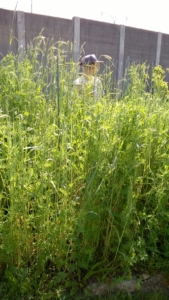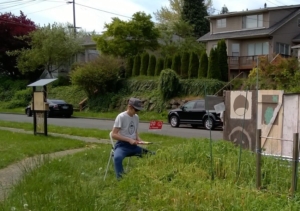Cover Crop Culture
August 28, 2022
Oh just throw some newspapers or burlap over the garden bed for the winter. That’s one approach, and it might keep the weeds down.
On the other hand, you can think of your relationship to your garden bed as reciprocal, much like you might think of land in general. Your summer crops, in order to grow, took nutrients from the soil. Then you harvested most or all of that crop. And for plant pathogen protection, you even did your best to dig out the roots of Brassica and Nightshade plants.
“Hey!”, says the soil, “I fed you, now you need to feed me!”
Cover crops feed the soil and dole out other services as well. They improve soil texture by keeping microbes happy and active, their roots drill holes which decreases compaction, and these plants slow nutrient leaching (by-product of our rainy winter weather). Also, in the spring when you chop them up and incorporate them in your soil, they provide a reservoir of nitrogen and other important plant nutrients.
for work parties, events
Please email to volunteer
freewayestatescommunityorchard@gmail
What does it take for the winter cover crop to succeed? Timing. We usually aim to get cover crop seeded by September 15, in order to be sure the plants will germinate and have some growth before winter.
Gardeners have their favorite cover crops. Many like to plant a combination of grasses (best for weed suppression) and legumes. One of three Fact Sheets from WSU, Cover Crops for Home Gardens West of the Cascades, states that cereal rye is one of the most common winter cover crops. The fact sheet has a chart of planting dates for the various crops, and also discusses summer cover crops.
One year I grew rye and vetch. Check out the biomass. (My niece is 5’10”.) Overkill! In the spring, I shear my cover crop an inch or two at a time, until I have reached soil level. I think this is easier than chopping to the ground and then trying to chop this green manure that is lying on top of the soil. Plus, your good shears stay free of gritty soil!
“But,” you say, “I will still be harvesting mid-September!” No problem. Just plant the cover crop seed anyway. It will take some time to germinate and start growing. Or, plant seed around crops still being harvested or overwintering.
In the spring, we chop the crop well before it goes to seed. The earlier you incorporate it into your bed the faster it will decompose, because it’s “hot”. (Similarly, the grass mowed early in the spring has more nitrogen than grass mowed later in the summer.)
The USDA website has a very impressive cover crop selection tool for the Northwest. Warning, you will need to use Microsoft Access to use the tool.
Also, here’s a link to a bit more information from the book, Sustainable Horticulture: Today and Tomorrow,
R. Poincelot, 2004, p. 372-377
https://depts.washington.edu/hortlib/pal/cover-crops-for-the-pacific-northwest/
Volunteers, please know that both Sue and I have assorted cover crop seeds to share.
Ruth




Thank you, Ruth for this very timely post! You have inspired me to get out there and sow more seed. Your tips are spot on:)
Happy harvesting! Amy in Port Townsend
Thanks, Ruth
Great piece, Ruth!